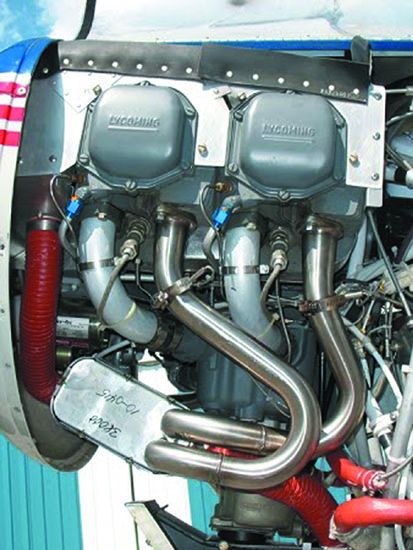When it comes to affordable methods of increasing aircraft performance—notably cruise speed—drag reduction is the most common. Approaching performance enhancement from the other end of the equation—applying more power—initially seems unrealistic because of the depressing realities of squared functions when it comes to power needed to obtain more speed. Plus, we’re quite aware of the cubic money spent trying to extract one or two more knots out of the Reno air racers.
However, because we’re talking about boosting cruise speeds only 5 to 10 percent, there are realistic and affordable ways to boost power for prices comparable to the drag reduction mods.
The oldest of the engine mods was developed by Power Flow Systems (www.powerflowsystems.com), founded by Laminar Flow Systems’ Robin Thomas.
Power Flow took a longtime auto racing technique of fine-tuning the engine’s exhaust system by customizing the length of each exhaust tube to cause the low pressure traveling down the tube behind an “exhaust puff” to reach the collector where the tubes join in time to suck out the exhaust from the next cylinder. This also creates a low pressure at each exhaust port at the time it opens to facilitate scavenging the products of combustion. Not surprisingly, Power Flow refers to its exhaust systems as “bolt-on horsepower.”
The result is an increase in horsepower on the order of 10 percent, a decrease in brake specific fuel consumption (BSFC) and an increase in torque.
We’ve flown behind Power Flow exhaust systems and have noted the shorter takeoff rolls and increased rates of climb, although we’ve done no testing. However, we have flown two Cessna 172s of the same vintage and powerplant, and were impressed with the hot day performance of the one with the Power Flow exhaust on days where the other struggles to clear the trees.
Power Flow makes few claims of speed increases, mostly stressing climb performance and reduced fuel burn—about 0.5 GPH at the same TAS. Where it does make claims of increased cruise speeds, its website says 5 MPH but notes that the increased speed comes with a 0.4 GPH fuel burn increase.
Power Flow acquired the assets of the other maker of customized exhausts, Leading Edge Exhaust Systems (LEES). Based in Anchorage, Alaska, LEES focused on increasing performance for aircraft regularly used in the bush—the Cessna 200 series and Piper PA-12s, -18s, -20s and -22s. Its systems were also substantially beefier than factory originals and were designed to last at least through TBO.
Power Flow is wrapping up the process of moving LEES’ equipment to its base in Florida and improving those exhausts to meet its internal QC requirements.
Prices for Power Flow’s original line of exhausts start at $5700; for the line it acquired from LEES, prices start at $3450. There are discounts available—check the website for details. The standard warranty is 12 months, but a 24-month warranty is available for selected airplanes if, once the exhaust system is installed, the owner has the prop dynamically balanced.
Power Flow offers its exhausts for the 180-HP Aviat Husky line (that’s a Power Flow exhaust on a Husky in the photo); Beech models 19 and 23; Cessna 170, 172, 175, 177, 177RG, 180, 182, 185, 205, 206, 207 and 210; Diamond DA 40; Grumman AA-5, -5A, -5B and AG-5B; Mooneys with 180-, 200- and 210-HP engines; and Piper PA-28 140, 150 and 160, PA-12, -18, -20 and -22.
• Electronic Ignition
In our June 2022 issue, we covered electronic ignition in detail. When it comes to performance, the bottom line is that replacing one mag with an electronic ignition unit that advances the timing to increase the power and efficiency of the combustion event means more horsepower and/or reduced fuel burn, depending on how the pilot chooses to take advantage of the mod.
SureFly (www.surefly.aero) offers its SureFly Ignition Module (SIM) for $1595 for a four-cylinder engine, $1895 for a six. It advances engine timing only in cruise, so there is no benefit in the climb. However, the cruise speed increase is measurable (and goes up with altitude) at the same fuel flow. At the same cruise speed, an owner can figure on a 10-15 percent reduction in fuel burn.
Electroair’s (www.electroair.net) electronic ignition is more sophisticated—adjusting during all phases of flight—and more expensive, starting at $2795 for a four-cylinder engine. In addition to a 1- to 2-GPH reduction in fuel burn at the same cruise speed, rate of climb and service ceiling should go up by 10 percent. If the pilot chooses to burn fuel at the pre-mod rate, our feedback from owners was a cruise speed increase of about 5 knots.


